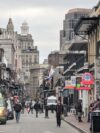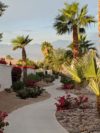While we enjoyed our visit in March to the Mojave National Preserve, we were disappointed to learn that it is not, and never was (except in the rarest of years), the right place to go to see desert blooms. That day, when I asked a ranger at the Preserve where the best place was to see desert blooms, he replied “Death Valley.” (Read the full story of that visit HERE.)
Death Valley didn’t fit into our original plans for travel in 2020. But, as our plans began to unravel as a result of the COVID-19 pandemic, we found ourselves within driving distance of Death Valley. Okay, I admit it. We didn’t just randomly find ourselves nearby. I planted a seed that Pahrump might be a good place for us to go and wait out the weeks until our service appointment in Las Vegas. Brian, anxious to get out of California before the state-wide lockdown, agreed. Pahrump just happened to be within driving distance of Death Valley National Park. And, you know, I love it when a plan comes together.
We managed to squeeze in our visit to Death Valley on the day the park officially closed to visitors. You can read about our visit HERE. I didn’t include much about the wildflowers in that post as I wanted to include images that Brian captured in addition to the ones I took.

If you do a Google image search for “Desert Super Bloom 2019,” you will get a glimpse of the pictures that left us wanting to see the desert bloom. The images present a patchwork quilt of wildflowers whose bright colors blanket the endless landscape. The pictures don’t show the flowers up-close, so you don’t really know how tiny many of the flowers really are. We knew it was highly unlikely for there to be two super-bloom years in a row. And we predicted correctly.
If you’re driving fast or even riding a bike fast by them, you might not notice any flowers. You have a better chance on foot, but if you’re actively involved in looking at the main sites of the park, i.e., the badlands, the dunes, the rock formations, etc., you might not notice them at all. Since part of our visit’s purpose included seeing flowers bloom, we searched for them and were rewarded by seeing many. Even looking at the image with Brian in it, you might not notice the flowers. However, if you look for the flowers, you might see a few spots of purple in the foreground or the pop of bright pink in the lower left third of the photo from a beavertail cactus.

Even without a super-bloom, there were literally millions of flowers in the park. Most of these were incredibly small, like the Nama Demissum, purple mat, shown below. Each flower was smaller than the size of a penny.

In the same area, near Zabriskie point, on the east side of the park, we saw many Desert Five Spot (Eremalche rotundifolia) which is considered to be one of the main flowers sought out by naturalists watching desert bloom. While not totally unique to Death Valley, they don’t grow everywhere. And, they have spots that make them easy to spot. 😊

With leaves of either purple or green, there is some variation between the flowers. In every case, they are delicate and quite beautiful with their light-purple outer petal color contrasting with the stark white interior which showcases five deep-colored spots.

We found Atrichoseris Platyphylla, Gravel Ghost, in this same area of the park. Gravel ghost grows up to three feet tall and, in season, can be found swaying in the breeze throughout the Mojave desert.

We noticed patches of wildflowers like the one below around the park. In this picture, I believe the yellow is Geraea canescens, commonly known as desert gold or desert sunflower. The purple includes some desert five-spot and two different species of Phacelia.

Someone I met this winter warned me about scorpion weed (Phacelia crenulata). Abundant across the desert, its bright purple flowers may be pretty, but it can also cause skin reactions like poison ivy. The name comes from the shape of the bloom. As it is top-heavy, the flower hangs over itself, creating the form of a scorpion’s tail. Just be careful not to get stung!

In this same area, we also saw many examples of Malacothrix glabrata, commonly called desert dandelion.

In the area of Mesquite Flat Dunes, I found one plant blooming that I didn’t recognize. I believe that it is Ambrosia salsola, commonly known as cheese bush because of a pungent, cheese-like scent produced when crushed.

Westward bound, we began to climb to higher elevations. With the change in altitude came a dramatic shift in plant-life. Brian caught a glimpse of red. We started watching for it, and we both saw other bright red spots, but high-speed limits and traffic prevented us from being able to stop.

We continued on to Father Crowley’s Vista. With views like this, you may have a better understanding of how easily you could miss seeing flowers smaller than your fingernail. But there were a few different flowers blooming up there, including what I identified as best as I’m able as Aliciella latifolia, broad-leafed gilia, and Pectocarya linearis, sagebrush comb-seed.


We headed back in the direction in which we came determined to find a place to pull over in search of the red flowers that we had seen earlier in the day. After we flew by the first patch of red, we slowed down and came to a stop just past the second bunch we saw.
Wanting to guarantee my sighting, I walked back to the bush we had just passed while Brian ventured out from the car. We both managed to see the brightly colored beauty of Desert Indian Paintbrush (Castilleja chromosa or angustifolia).

We saw other flowers during our visit, like California brittlebush, apricot mallow, and Bigelow’s coreopsis. Somehow, we didn’t get pictures of those while in the park. And as I wanted only to include pictures that we took that day, I’ve left them out of this post.
I’ve taken loads of pictures of flowers since we started our motorhome adventure. The desert was the last place that I thought I would find to do this, but I’m glad I’m wrong. Again, it seems that we’ve only just begun to discover what the desert and this country has to offer.
P.S. I’ve done my best to correctly identify the flowers here. If you see that I’ve gotten something wrong, please don’t hesitate to correct me either by commenting on my post or by sending me an email at anne@ontheroadofadventure.com.




